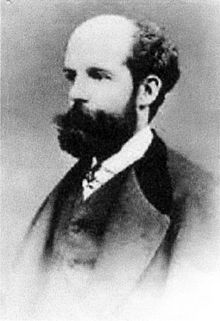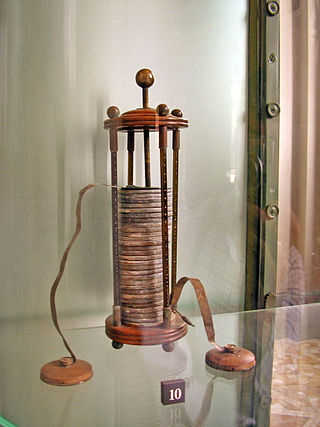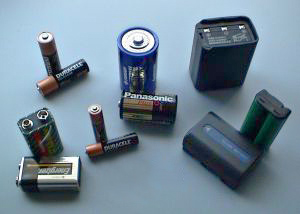
Georges Leclanché (9 October 1839 – 14 September 1882) was a French electrical engineer chiefly remembered for his invention of the Leclanché cell, one of the first modern electrical batteries and the forerunner of the modern dry cell battery.

Georges Leclanché (9 October 1839 – 14 September 1882) was a French electrical engineer chiefly remembered for his invention of the Leclanché cell, one of the first modern electrical batteries and the forerunner of the modern dry cell battery.
Leclanché was born in 1839 in Parmain (Seine-et-Oise), France, the son of Léopold Leclanché and Eugenie of Villeneuve. Due to the political situation in France, and because his father was a former minister, his parents, also friends of the writer Victor Hugo, decided to take the way of exile in the United Kingdom. He was thus educated in England but completed his education at École Centrale des Arts et Manufactures (École Centrale Paris), one of the top engineering schools in France, graduating in 1860 to begin work as an engineer. He first worked for a French railways company where he was in charge of communication infrastructures related to the electrical transmission of time. His interest for the development of efficient electrical cells arose from the problems affecting the existing generation of cells used at this time in the railways. Because of the political situation in France, he emigrated in Brussels in Belgium where he built a small laboratory. It is there that he developed a first cell based on copper carbonate and then his electrical cell based on zinc reducing agent and manganese oxide oxidizing agent. His invention was rapidly adopted by the Belgian telegraph administration and the railways company of The Netherlands.
After the fall of Napoléon III, he came back in France in Paris where he became associated with Ernest Barbier to found the cells factory "Leclanché-Barbier". He was the main manufacturer of cells in France. Georges Leclanché died from a throat cancer [1] on 14 September 1882 in Paris around the age of 43.
After his death, his brother Maurice took over the business and his son Max also continued to improve and to commercialise his invention.
In 1866 he invented the Leclanché cell, one of the first electrical batteries and the forerunner of the modern dry cell battery. It comprised a conducting solution (electrolyte) of ammonium chloride with a negative terminal of zinc (anode/oxidation) and a positive terminal of manganese dioxide (cathode/reduction). [2] [3]
Leclanché's "wet cell" (as it was popularly called) was the forerunner to the world's first widely used battery, the zinc–carbon battery.
In 1876, Leclanché jellifies the electrolyte of his cell by adding starch to the ammonium chloride, making his cell more portable. [4]
The Leclanché factory successfully developed until the beginning of the 20th century when it encountered the concurrence of many new producers such as the Wonder cells (founded in 1914). The enterprise changed several times of hands, was bought by the Fulmen battery company and finally by the CGE group.
The name Leclanché is presently used by a company based in Yverdon in Switzerland and founded in 1909. In 2006, this company acquired the German society Bullith which became the "Leclanché Lithium GmbH", based today in Willstätt (Baden-Württemberg in Germany).

Alessandro Giuseppe Antonio Anastasio Volta was an Italian physicist and chemist who was a pioneer of electricity and power, and is credited as the inventor of the electric battery and the discoverer of methane. He invented the voltaic pile in 1799, and reported the results of his experiments in a two-part letter to the president of the Royal Society, which was published in 1800. With this invention, Volta proved that electricity could be generated chemically and debunked the prevalent theory that electricity was generated solely by living beings. Volta's invention sparked a great amount of scientific excitement and led others to conduct similar experiments, which eventually led to the development of the field of electrochemistry.

Electrochemistry is the branch of physical chemistry concerned with the relationship between electrical potential difference and identifiable chemical change. These reactions involve electrons moving via an electronically conducting phase between electrodes separated by an ionically conducting and electronically insulating electrolyte.

The voltaic pile was the first electrical battery that could continuously provide an electric current to a circuit. It was invented by Italian chemist Alessandro Volta, who published his experiments in 1799. Its invention can be traced back to an argument between Volta and Luigi Galvani, Volta's fellow Italian scientist who had conducted experiments on frogs' legs. Use of the voltaic pile enabled a rapid series of other discoveries, including the electrical decomposition (electrolysis) of water into oxygen and hydrogen by William Nicholson and Anthony Carlisle (1800), and the discovery or isolation of the chemical elements sodium (1807), potassium (1807), calcium (1808), boron (1808), barium (1808), strontium (1808), and magnesium (1808) by Humphry Davy.

Manganese dioxide is the inorganic compound with the formula MnO
2. This blackish or brown solid occurs naturally as the mineral pyrolusite, which is the main ore of manganese and a component of manganese nodules. The principal use for MnO
2 is for dry-cell batteries, such as the alkaline battery and the zinc–carbon battery. MnO
2 is also used as a pigment and as a precursor to other manganese compounds, such as KMnO
4. It is used as a reagent in organic synthesis, for example, for the oxidation of allylic alcohols. MnO
2 has an α-polymorph that can incorporate a variety of atoms in the "tunnels" or "channels" between the manganese oxide octahedra. There is considerable interest in α-MnO
2 as a possible cathode for lithium-ion batteries.

An alkaline battery is a type of primary battery where the electrolyte has a pH value above 7. Typically these batteries derive energy from the reaction between zinc metal and manganese dioxide.

A dry cell is a type of electric battery, commonly used for portable electrical devices. Unlike wet cell batteries, which have a liquid electrolyte, dry cells use an electrolyte in the form of a paste, and are thus less susceptible to leakage.
Lewis Frederick Urry was a Canadian-American chemical engineer and inventor. He invented both the alkaline battery and lithium battery while working for the Eveready Battery company.

A zinc–air battery is a metal–air electrochemical cell powered by the oxidation of zinc with oxygen from the air. During discharge, a mass of zinc particles forms a porous anode, which is saturated with an electrolyte. Oxygen from the air reacts at the cathode and forms hydroxyl ions which migrate into the zinc paste and form zincate, releasing electrons to travel to the cathode. The zincate decays into zinc oxide and water returns to the electrolyte. The water and hydroxyl from the anode are recycled at the cathode, so the water is not consumed. The reactions produce a theoretical voltage of 1.65 Volts, but is reduced to 1.35–1.4 V in available cells.

The Daniell cell is a type of electrochemical cell invented in 1836 by John Frederic Daniell, a British chemist and meteorologist, and consists of a copper pot filled with a copper (II) sulfate solution, in which is immersed an unglazed earthenware container filled with sulfuric acid and a zinc electrode. He was searching for a way to eliminate the hydrogen bubble problem found in the voltaic pile, and his solution was to use a second electrolyte to consume the hydrogen produced by the first. Zinc sulfate may be substituted for the sulfuric acid. The Daniell cell was a great improvement over the existing technology used in the early days of battery development. A later variant of the Daniell cell called the gravity cell or crowfoot cell was invented in the 1860s by a Frenchman named Callaud and became a popular choice for electrical telegraphy.

A zinc–carbon battery (or carbon zinc battery in U.S. English) is a dry cell primary battery that provides direct electric current from the electrochemical reaction between zinc (Zn) and manganese dioxide (MnO2) in the presence of an ammonium chloride (NH4Cl) electrolyte. It produces a voltage of about 1.5 volts between the zinc anode, which is typically constructed as a cylindrical container for the battery cell, and a carbon rod surrounded by a compound with a higher Standard electrode potential (positive polarity), known as the cathode, that collects the current from the manganese dioxide electrode. The name "zinc-carbon" is slightly misleading as it implies that carbon is acting as the oxidizing agent rather than the manganese dioxide.
Leclanché is a Swiss lithium-ion cells and related technologies manufacturer founded in 1909. It currently employs over 350 staff and is listed on the SIX Swiss Exchange. The company has its headquarters in Yverdon-les-Bains, Switzerland and production facilities in Willstätt in the state of Baden-Württemberg, Germany. Leclanché is the only listed pure play energy storage company in the world.
Electrochemistry, a branch of chemistry, went through several changes during its evolution from early principles related to magnets in the early 16th and 17th centuries, to complex theories involving conductivity, electric charge and mathematical methods. The term electrochemistry was used to describe electrical phenomena in the late 19th and 20th centuries. In recent decades, electrochemistry has become an area of current research, including research in batteries and fuel cells, preventing corrosion of metals, the use of electrochemical cells to remove refractory organics and similar contaminants in wastewater electrocoagulation and improving techniques in refining chemicals with electrolysis and electrophoresis.

The Leclanché cell is a battery invented and patented by the French scientist Georges Leclanché in 1866. The battery contained a conducting solution (electrolyte) of ammonium chloride, a cathode of carbon, a depolarizer of manganese dioxide (oxidizer), and an anode of zinc (reductant). The chemistry of this cell was later successfully adapted to manufacture a dry cell.

Batteries provided the primary source of electricity before the development of electric generators and electrical grids around the end of the 19th century. Successive improvements in battery technology facilitated major electrical advances, from early scientific studies to the rise of telegraphs and telephones, eventually leading to portable computers, mobile phones, electric cars, and many other electrical devices.
The National Carbon Company was a dominant American manufacturer of batteries and lighting products in the early 20th century. It was founded in 1886 by the former Brush Electric Company executive W. H. Lawrence, in association with Myron T. Herrick, James Parmelee, and Webb Hayes, son of U.S. President Rutherford B. Hayes, in Cleveland, Ohio. In 1890, National Carbon merged with Thomson-Houston, Standard Carbon, and Faraday Carbon. In 1906 it invested in what became the Eveready Battery Company, which it purchased in 1914. National Carbon was acquired in 1917 by Union Carbide.

Gustave Pierre Trouvé was a French electrical engineer and inventor in the 19th century. A polymath, he was highly respected for his innovative skill in miniaturization.

An electric battery is a source of electric power consisting of one or more electrochemical cells with external connections for powering electrical devices. When a battery is supplying power, its positive terminal is the cathode and its negative terminal is the anode. The terminal marked negative is the source of electrons. When a battery is connected to an external electric load, those negatively charged electrons flow through the circuit and reach to the positive terminal, thus cause a redox reaction by attracting positively charged ions, cations. Thus converts high-energy reactants to lower-energy products, and the free-energy difference is delivered to the external circuit as electrical energy. Historically the term "battery" specifically referred to a device composed of multiple cells; however, the usage has evolved to include devices composed of a single cell.

Carl Gassner was a German physician, scientist and inventor, better known to have contributed to improve the Leclanché cell and to have fostered the development of the first dry cell, also known as the zinc–carbon battery, less likely to break or leak and that could be effectively industrially produced at large scale.

Lazare Weiller was a French engineer, industrialist, and politician. He was born in Alsace and received a technical education in England and in his cousin's copper factory in Angoulême. He was very interested in the physical sciences, particularly the use of electricity to transmit sound and images. He proposed a system for scanning, transmitting and displaying images that was the basis for experiments by various television pioneers. He sponsored early aviation experiments by the Wright brothers. He founded several companies including a telephone wire manufacturer, a taximeter manufacturer, the first Parisian cab company to use automobiles, an aircraft company and a wireless telegraphy company. He was a deputy during World War I (1914–18) and then a senator until his death.

Battery leakage is the escape of chemicals, such as electrolytes, within an electric battery due to generation of pathways to the outside environment caused by factory or design defects, excessive gas generation, or physical damage to the battery. The leakage of battery chemical often causes destructive corrosion to the associated equipment and may pose a health hazard.
This article includes a list of general references, but it lacks sufficient corresponding inline citations .(December 2017) |